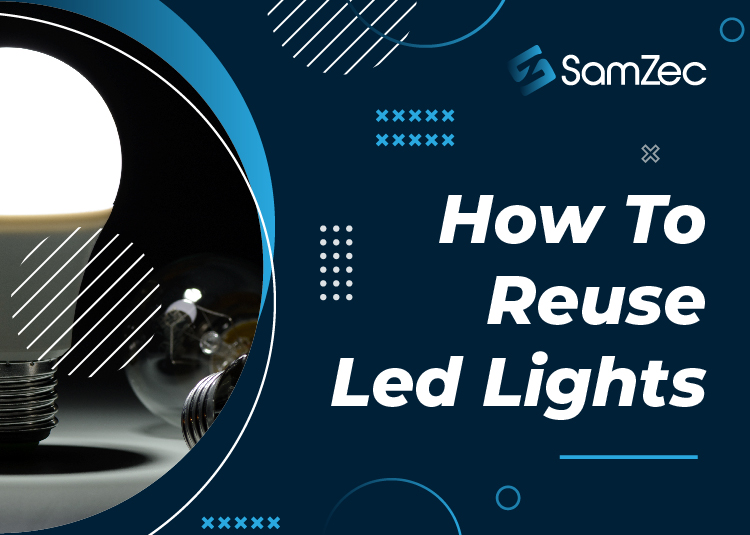Unused electronic components such as light-emitting diodes (LEDs) and transistors are often wasted despite functioning normally. I want to change this by telling you how to reuse LED lights in new and exciting ways. This article will focus on using LEDs and resistors, but the idea can be applied to almost any type of component.
Circuits are made up of two or more electrical conductors linked together by a path called a circuit. Typically this path is made using a material that conducts electricity (such as copper or aluminum wire). The circuit will usually contain resistors, capacitors, transistors, LEDs, and integrated circuits.
The way these components are connected determines what type of circuit it is; There are many different types of circuits that all do different things. For example, one particular type of circuit called an electric field causes electrons to flow along the conductors at high speed in a steady stream – we call this electrical flow current.
Another type of circuit uses electric currents, which change rapidly with time; we call these signals, and they’re essential because they can be used to represent information such as sound waves or images.
An electric current is produced when free electrons move through an electrical conductor with an electric field across it, which occurs whenever Voltage is applied. We call this the electromotive force of the circuit – more on that in a minute!
Every part has resistance to current flow, and in circuits, we usually think about this as ohms. The relationship between the amount of voltage supplied to a part, and the resulting current flowing through it is determined by its resistance. If we want higher currents, we will need to increase the Voltage or reduce the resistance; likewise, we can use less Voltage or add resistance if we want lower currents.
A resistor works by adding resistance to a circuit, so they’re probably one of the simplest components out there. They’re typically used to limit the amount of current flowing through a circuit, and they come in lots of different standard sizes measured in ohms.
You can also get resistors with built-in protection against overvoltages called varistors or transient voltage suppressor diodes (TVS). Both protect against large overvoltage spikes that could damage semiconductor parts like transistors by absorbing the excess energy.
There’s often more than one resistor in a circuit because different parts require different currents to operate correctly; for example, if you use too much current, it may destroy the part. If you put two or more resistors in series with each other, then their combined resistance is equal to the sum of their resistances. It means that the current flowing through them equals the current flowing through each resistor added together; we call this adding in series.
There are other ways we can use resistors, too, such as splitting a high-powered signal into several lower-power ones and limiting currents (how much current flows). It is called dividing or sinking, and it’s done by connecting two or more resistors to a common connection point on the circuit where the Voltage is present.
The most exciting things about LEDs are How To Reuse Led Lights and how bright they are when you apply just a few milliamps of electricity! Typically they operate at around 2 volts, but they can be damaged if you put more than 2.5 volts across them, so they’re one of the few components that have a maximum rating measured in volts.
LEDs are just a particular type of diode, which is a component that allows electricity to flow mostly in only one direction. In the case of LEDs, current flows through them from an anode (positive side) to a cathode (negative side). So the simplest LED circuits contain just two parts:
- LED and one resistor. It ensures the current flowing through it never gets too high because all Voltage less than
- 1 volts is considered “forward bias,” and it passes straight through while anything over this Voltage is considered “reverse bias” and can’t pass without causing damage.
This is one of the reasons LEDs are so efficient because most of their energy escapes as light rather than being wasted in the form of heat like with incandescent bulbs. It makes them ideal for portable devices, and they last a lot longer too!
Power supplies generate a specific voltage using a transformer that steps down high voltages from mains electricity to usable levels. To get something useful out of these power supplies, we need to convert the highly high voltages into alternating current (AC) before cutting it off at a specific frequency to make it usable for digital components.
To measure the amount of electricity going in and out of a circuit, we have special units called watts which tell us how much energy is being used per second. These are defined by multiplying the voltage present in a circuit by the current going through it, so to get a watt reading, we need to know both what Voltage and current are being used.
Depending on how big the LEDs are, they will need different amounts of power, which varies with color. It’s essential not to use more power than you have to because wasting energy wastes money! In some cases, this might mean that if your LED strip doesn’t seem bright enough, you can add extra resistors into series without changing the overall effect. So now you know all about How To Reuse Led Lights, let’s look at some exciting ways to use LEDs!
You’re going to need a resistor to limit the current going through your LED because LEDs are very inefficient, and they can be damaged by too much current.
If you wire LEDs in parallel, then to make them work, all you need is a single resistor which won’t reduce their brightness by much.
To power multiple LEDs from one supply, you might want to use a transistor, but only if the battery or power supply doesn’t have enough Voltage; otherwise, it may cause damage. Also, resistors aren’t needed in this case because a transistor is a type of component called an electronic switch which means it’s already doing the job of limiting currents!
To allow more current into an LED circuit, we can put another resistor in series with one that’s already in there. Of course, it will slow things down and reduce the brightness somewhat, but it’s effective and great for neatening up all those wires we’ve been using!
From now on, I’m just going to be talking about how many LEDs you can power from a single resistor because this is generally more interesting than how bright they are at a specific voltage. The formula to work out how much current each of your LEDs needs is: Volts divided by 2 = Amps Resistor divided by the number of LEDs = Voltage divided by current, So if you have 1 LED running from 12 volts with a 470 Ohm resistor, then the current would be 12/2 – 470/1 = 5.5 amps.
If you want to run 10 LEDs at 6 volts you’d do the same calculations, but the numbers would be 6/2 – 54/10 = 0.54 amps. To work out how many LEDs you can fit into a circuit, check out this excellent LED calculator.
I’ve mentioned earlier that blue LEDs need three times more electricity than red ones, which means they are brighter when put under the same current! Red ones are generally cheaper, too, because they are made from pinkish orange LEDs which have been tinted. On the other hand, blue LEDs are made from pure bluish-white LEDs, so it costs more money to make them!
You’ll notice that small LEDs have a single flat side and larger ones have 2 or 3. The flat side is the negative terminal, and all you need to do is push them into a circuit in the right direction to work already!
Conclusion:
We can use LEDs as light sources in many different ways, but probably most interesting are the RGB (Red Green Blue) LEDs, which give us over 16 million different colors.
To make these, we need more sophisticated circuits with resistors, transistors, and capacitors, which let us reduce the current through certain parts of our circuit when we want one LED to be brighter than another. It’s also essential that electricity flows in a loop around our whole circuit because it makes everything much more efficient. I hope you enjoyed this guide on How To Reuse Led Lights.




















